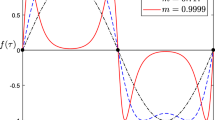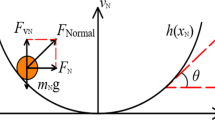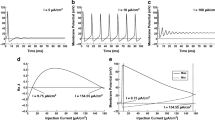Summary
In response to point-stimulation with a constant current, a neuron may propagate a repetitive train of action potentials along its axon. For maintained repetitive activity, the current strength I must be, typically, neither too small nor too large. For I outside some range, time independent steady behavior is observed following a transient phase just after the current is applied. We present analytical results for a piecewise linear FitzHugh-Nagumo model for a point-stimulated (non-space-clamped) nerve which are consistent with this qualitative experimental picture. For each value of I there is a unique, spatially nonuniform, steady state solution. We show that this solution is stable except for an interval (I *, I *) of I values. Stability for I too small or too large corresponds to experiments with sub-threshold I or with excessive I which leads to ‘nerve block’. For I = I *, I * we find Hopf bifurcation of spatially nonuniform, time periodic solutions. We conclude that (I *, I *) lies interior to the range of I values for repetitive activity. The values of I * and I * and their dependence on the model parameters are determined. Qualitative differences between results for the point-stimulated configuration and the space-clamped case are discussed.
Similar content being viewed by others
References
Calvin, W. H., Schwindt, P. C.: Steps in production of motoneuron spikes during rhythmic firing. J. Neurophysiol. 35, 297–310 (1972)
Carpenter, G. A.: A geometric approach to singular perturbation problems with applications to nerve impulse equations, J. Diff. Eqns. 23, 335–367 (1977)
Casten, R., Cohen, H., Lagerstrom, P.: Perturbation analysis of an approximation to Hodgkin-Huxley theory. Quart. Appl. Math. 32, 365–402 (1975)
Cole, K. S., Antosiewicz, H. A., Rabinowitz, P.: Automatic computation of nerve excitation. J. SIAM 3, 153–172 (1955)
Cooley, J., Dodge, F., Cohen, H.: Digital computer solutions for excitable membrane models. J. Cell. Comp. Physiol. 66, Supp. 2, 99–109 (1965)
Cooley, J. W., Dodge, F. A.: Digital computer solutions for excitation and propagation of the nerve impulse. Biophys. J. 6, 583–599 (1966)
FitzHugh, R., Antosiewicz, H. A.: Automatic computation of nerve excitation-detailed corrections and additions. J. SIAM 7, 447–458 (1959)
FitzHugh, R.: Impulses and physiological states in models of nerve membrane. Biophys. J. 1, 445–466 (1961)
Guttman, R. Barnhill, R.: Oscillation and repetitive firing in squid axons. Comparison of experiments with computations. J. Gen. Physiol. 55, 104–118 (1970)
Hastings, S. P.: The existence of homoclinic and periodic orbits for the FitzHugh-Nagumo equations. Quart. J. Math., Oxford 27, 123–134 (1976)
Hodgkin, A. L., Huxley, A. F.: A quantitative description of membrane current and its application to conduction and excitation in nerve, J. Physiol. (London) 117, 500–544 (1952)
Hopf, E.: Abzweigung einer periodischen Lösung von einer stationären Lösung eines Differentialsystems. Bericht der Mathematisch-Physischen Klasse der Sächsischen Akademie der Wissenschaften zu Leipzig. 94, 3–22 (1942)
Jack, J. J. B., Noble, D., Tsien, R. W.: Electric Current Flow in Excitable Cells. London: Oxford University Press (1975)
McKean, H. P.: Nagumo's equation. Advances in Mathematics 4, 290–223 (1970)
Marsden, J. E., McCracken, M.: The Hopf bifurcation and its applications. Applied Mathematical Sciences 19. Berlin-Heidelberg-New York: Springer (1976)
Messiah, A.: Quantum Mechanics, Vol. I. Amsterdam: North Holland, New York: Wiley (1961)
Nagumo, J., Arimoto, S., Yoshizawa, S.: An active pulse transmission line simulating nerve axon. Proc. IRE. 50, 2061–2070 (1962)
Rinzel, J., Keller, J. B.: Traveling wave solutions of a nerve conduction equation. Biophys. J. 13, 1313–1337 (1973)
Sabah, N. H., Spangler, R. A.: Repetitive response of the Hogdkin-Huxley model for the squid giant axon. J. Theoret, Biol. 29, 155–171 (1970)
Schiff, L. I.: Quantum Mechanics. New York: McGraw-Hill (1949)
Sleeman, B. D.: FitzHugh's nerve axon equations. J. Math. Biol. 2, 341–349 (1975)
Stein, R. B.: The frequency of nerve action potentials generated by applied currents. Proc. R. Soc. (London) B 167, 64–86 (1967)
Terzuolo, C. A., Washizu, Y.: Relation between stimulus strength, generator potential and impulse frequency in stretch receptor of Crustacea. J. Neurophysiol. 25, 56–66 (1962)
Tomita, T., Wright, E. B.: A study of the crustacean axon repetitive response: I. The effect of membrane potential and resistance. J. Cell. Comp. Physiol. 65, 195–209 (1965)
Troy, W. C.: Oscillation phenomena in nerve conduction equations. Doctoral thesis, State University of New York at Buffalo (1974)
Troy, W. C.: The bifurcation of periodic solutions in the Hodgkin-Huxley equations. Quart. J. Math., Oxford (to appear)
Author information
Authors and Affiliations
Rights and permissions
About this article
Cite this article
Rinzel, J. Repetitive activity and hopf bifurcation under point-stimulation for a simple FitzHugh-Nagumo nerve conduction model. J. Math. Biology 5, 363–382 (1977). https://doi.org/10.1007/BF00276107
Received:
Issue Date:
DOI: https://doi.org/10.1007/BF00276107




